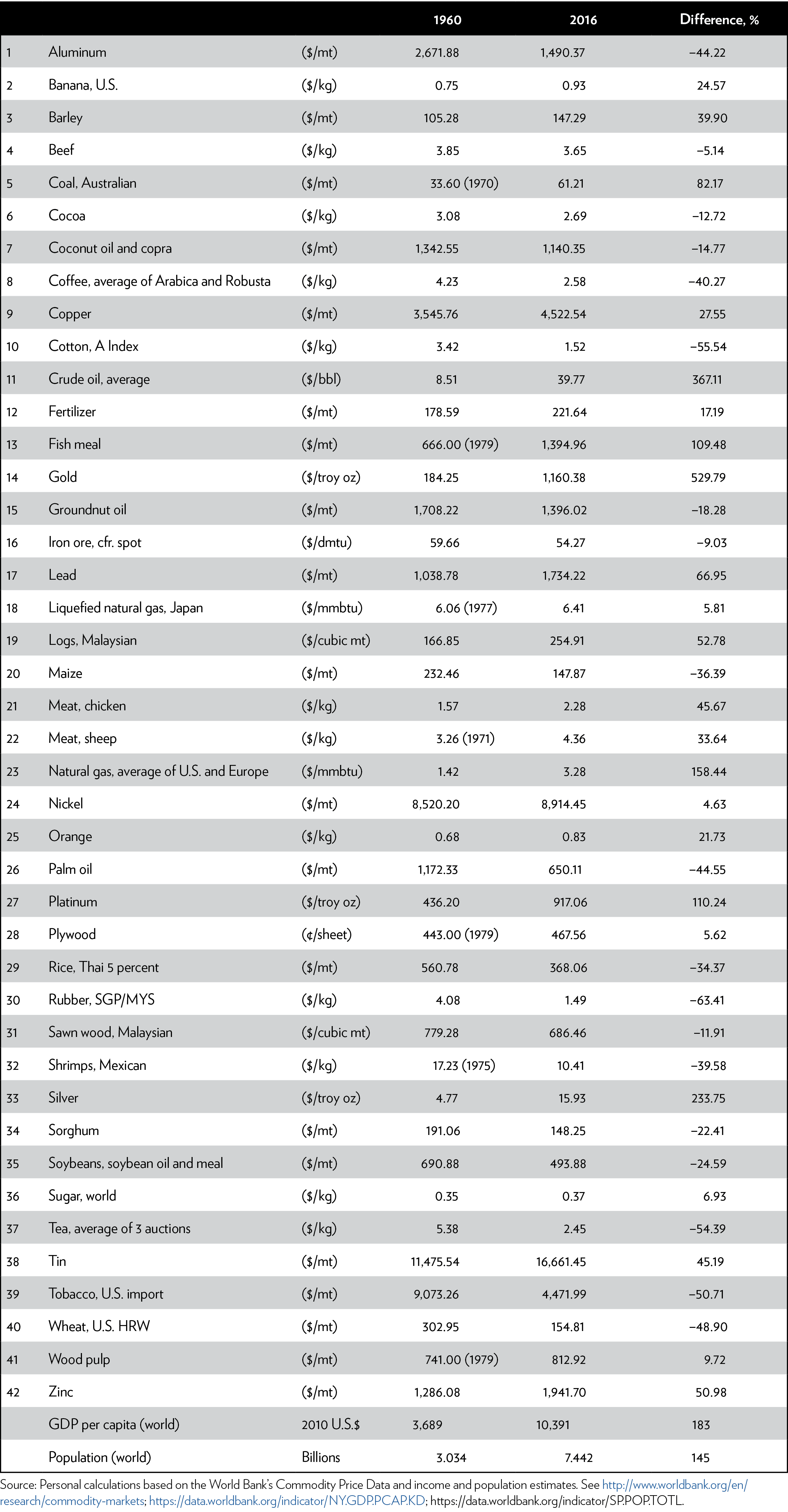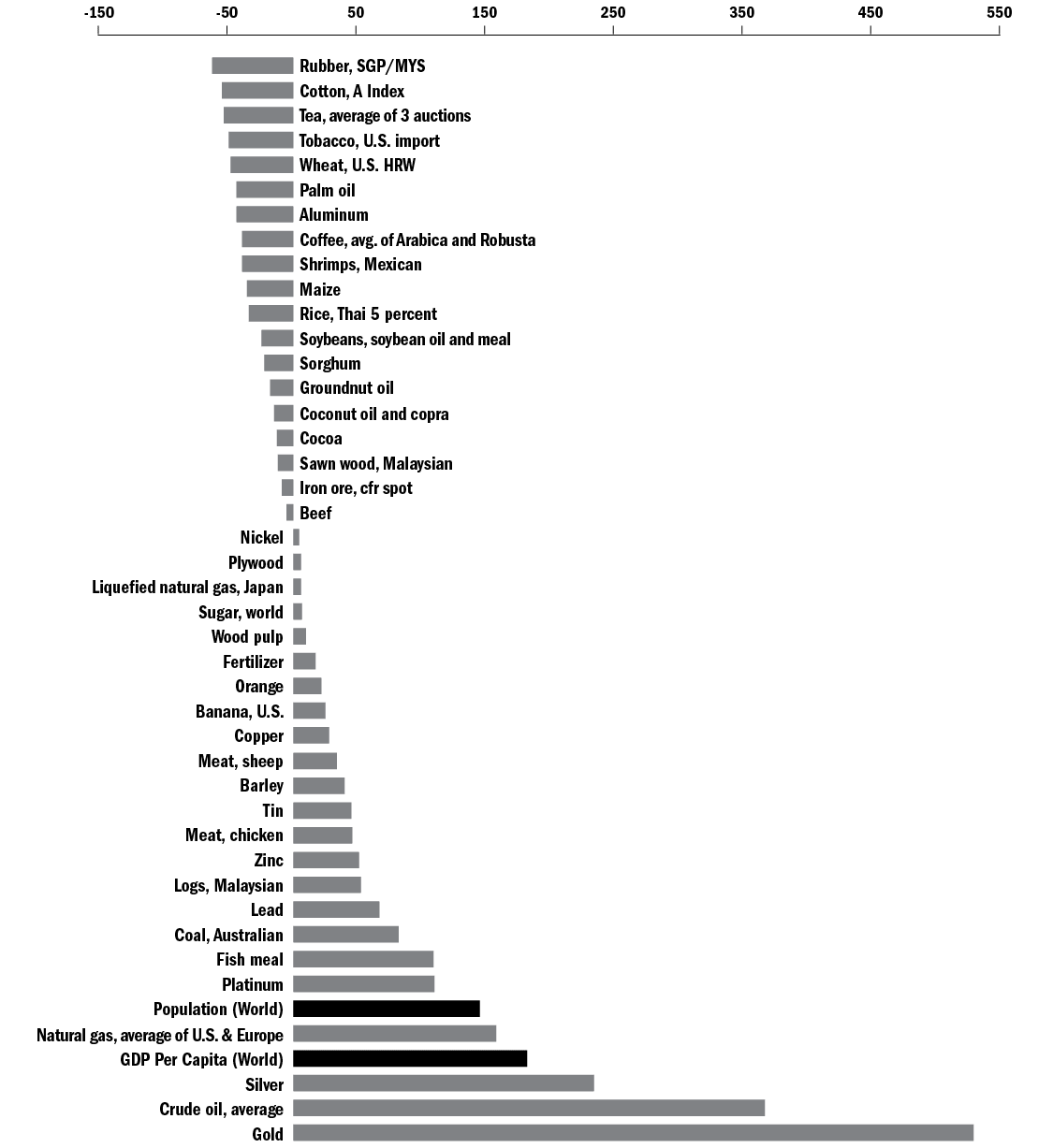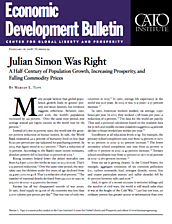How can one explain this unprecedented improvement in global well-being? Some of it must be attributed to technological and scientific progress. Also, specialization and trade played a vital role in improving the state of the world. Globalization ensured that an increase in the world’s population translated to an increase in the world’s productivity.
Of course, growth required the use of massive amounts of natural resources. How much of our natural wealth remains? Although we do not know the size of most reserves of natural resources, we can ascertain their scarcity or abundance by looking at prices. As this paper shows, after 56 years of human use and exploration, the vast majority of the commodities tracked by the World Bank are cheaper than they used to be — either absolutely or relative to income.
These findings would come as no surprise to the late Julian Simon (1932–1998), who years ago explained and predicted the happy confluence of growing population, increasing wealth, and falling commodity prices. In his 1981 book The Ultimate Resource, Simon noted that humans are intelligent animals who innovate their way out of scarcity through greater efficiency, increased supply, or development of substitutes. Human ingenuity, in other words, is “the ultimate resource” that makes other resources more plentiful. 18
An aluminum can, for example, weighed about 3 ounces in 1959. Today, it weighs less than half an ounce. 19 In other cases, we have replaced scarce resources with those that are more plentiful. Instead of killing whales for lamp oil, for instance, we burn coal, oil, and gas. In fact, humanity is yet to run out of a single nonrenewable resource.
Although past performance does not guarantee future results, constant predictions of doom and gloom should be put in perspective. Humanity has solved many challenges in the past, and there is no reason to believe that we will not be able to solve problems in the future. Put differently, there is no compelling evidence to support calls for mandatory curbs on human reproduction and consumption.
To see what has been happening to world commodity prices, I looked at the World Bank’s Commodity Price Data, which include prices for 72 commodities (see Appendix). The data set needed some consolidation because some data sets started very late (e.g., 1996) or were repetitive (e.g., there were four different tea price data sets). As a consequence, I was left with 42 distinct data sets.
More specifically, I eliminated three crude oil data sets (Brent, Dubai, and WTI) because the data contained therein were already reflected in “Crude oil, average.” Because no measure of the price of coal goes back to 1960, I kept “Coal, Australian,” which goes back to 1970 and contains the most data. (Incidentally, “Crude oil, average” and “Coal, Australian,” have both appreciated more than was the case with prices in the eliminated data sets.)
In the case of natural gas, prices in the United States and Europe diverged significantly. 20 However, since I am trying to compare global prices and global income, I created an average price of natural gas consisting of both the American and European prices. To simplify matters further, I created a single average for the prices of coffee (combining Arabica and Robusta) and retained just one measure of the price of tea, which is, in any case, the average of the prices in Colombo, Kolkata, and Mombasa.
I also combined coconut oil and copra (from which coconut oil is derived). I eliminated groundnuts, for which price tracking did not start until 1980, with groundnut oil serving as a proximate measure of the price of groundnuts. I eliminated palm kernel oil because its price tracking doesn’t start until 1996, and I combined all soybean price measures into one. I eliminated all prices for rice except for the one measure that actually starts in 1960, “Rice, Thai 5 percent.”
Similarly, I retained the only measure of wheat (Wheat, U.S. HRW) that goes back to 1960. I eliminated “Banana, Europe” because it didn’t start until 1997. I eliminated sugar prices in the United States and Europe, retaining “Sugar, world” instead. I eliminated “Logs” and “Sawn wood” from Cameroon because both data sets start in 1970. “Rubber, TSR20” was eliminated because of its start in 1999. I also eliminated “DAP” (i.e., diammonium phosphate) because it started in 1967, and I combined the other four fertilizers (phosphate rock, triple superphosphate, urea, and potassium chloride) into one price measure called “Fertilizer.”
Between 1960 and 2016, world population increased by 145 percent and average income per capita adjusted for inflation increased by 183 percent. Out of the 42 distinct commodity prices measured by the World Bank, 19 have declined in absolute terms. In other words, adjusted for inflation, those commodities were cheaper in 2016 than in 1960. Twenty-three commodities have increased in price over the past 56 years. However, of those 23 commodities, only 3 (crude oil, gold, and silver) appreciated more than income. In a vast majority of cases, therefore, commodities became cheaper either absolutely or relatively (see Table 1 and Figure 1).
Table 1: Commodity Prices, 1960–2016 (2010 U.S. dollars)
Note: bbl = barrel; cfr = cost and freight; dmtu = dry metric tonne unit; HRW = Hard Red Winter; kg = kilogram; mmbtu = million British thermal units; mt = metric ton; MYS = Malaysia; oz = ounce; SGP = Singapore; troy oz = troy ounce.
Figure 1: Commodity Prices, Population and Income, Percent Change, 1960–2016
Source: Personal calculations based on the World Bank’s Commodity Price Data and income and population estimates. See
http://www.worldbank.org/en/research/commodity-markets;
http://data.worldbank.org/indicator/NY.GDP.PCAP.KD;
https://data.worldbank.org/indicator/SP.POP.TOTL.
Note: cfr = cost and freight; HRW = Hard Red Winter; kg = kilogram; MYS = Malaysia; SGP = Singapore.
It is often posited that population growth must inevitably result in the exhaustion of natural resources, environmental destruction, and even mass starvation. Take, for example, the report The Limits to Growth, which was published by the Club of Rome in 1972. 21 The report, which was based on Massachusetts Institute of Technology computer projections, looked at the interplay between industrial development, population growth, malnutrition, the availability of nonrenewable resources, and the quality of the environment. It concluded that “If present growth trends in world population, industrialization, pollution, food production, and resource depletion continue unchanged, the limits to growth on this planet will be reached sometime within the next one hundred years. . . . The most probable result will be a rather sudden and uncontrollable decline in both population and industrial capacity. . . . Given present resource consumption rates and the projected increase in these rates, the great majority of currently nonrenewable resources will be extremely expensive 100 years from now.” 22
That kind of alarmism is not ancient history. A recent article in the journal Nature Sustainability argued that





